Exam 3 (Chapters 8-11)
1/175
Earn XP
Description and Tags
Made by @agreyr
Name | Mastery | Learn | Test | Matching | Spaced |
|---|
No study sessions yet.
176 Terms
Testes
Produce sperm cells
Ovaries
Produce ova
Steroid hormones produced by both gonads
Androgens (Testosterone), Estrogens (Estradiol), Progestins (Progesterone)
Gonadotropin releasing hormone (GnRH)
Produced by hypothalamic neuroendocrine cells, secreted into the blood vessels and carried to the anterior pituitary via hypothalamic-pituitary portal system (see Neuroendocrine System: Regions)
Gonadotropins
Released by anterior pituitary following GnRH
Follicle Stimulating Hormone and Luteinizing Hormone
Drive the release of gonadal steroid hormones
Two major effects of sex hormones
Organizational (developmental) and activational
Organizational effects on gonads
Indifferent (primordial) gonads
Presence of a Y chromosome triggers the synthesis of SRY protein at about 6 weeks of development; allows growth of the medulla into the testes while the cortex shrinks away

Organizational effects on internal organs
At 6 weeks, zygote contains two precursor duct systems (Wolffian system and Müllerian system)
Once formed, fetal testes release testosterone and Müllerian-inhibiting hormone (8 weeks of gestation)
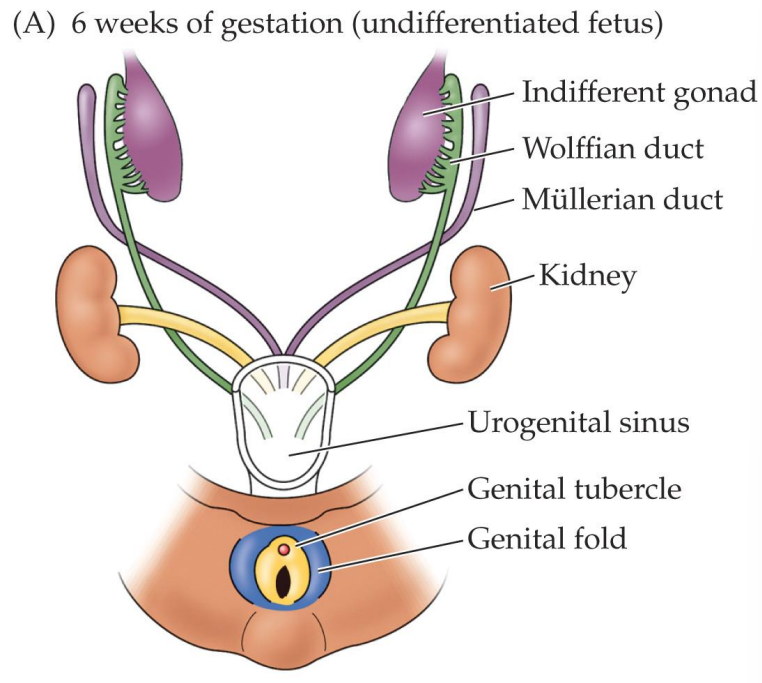
Wolffian system
One of the two precursor duct systems present zygote at 6 weeks
Potential to develop into epididymis, vas deferens, and seminal ducts
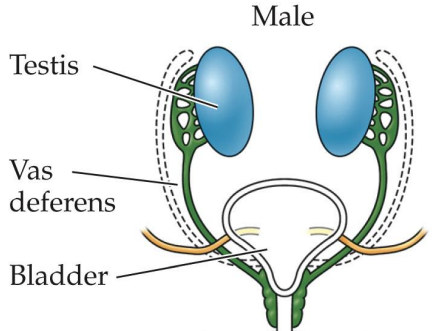
Müllerian system
One of the two precursor duct systems present zygote at 6 weeks
Potential to develop into fallopian tubes, uterus, and inner vagina
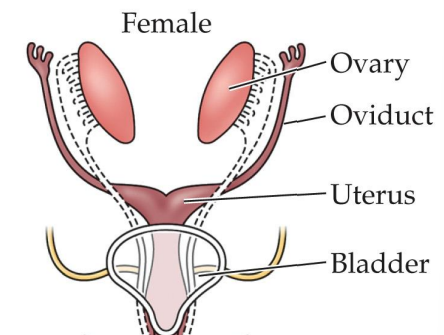
Male reproductive organ development
XY chromosome; Y chromosome being testis-determining factor
Primordial gonads develop into testes; anti-Müllerian hormone and androgens are produced
Defeminization and masculinization occur
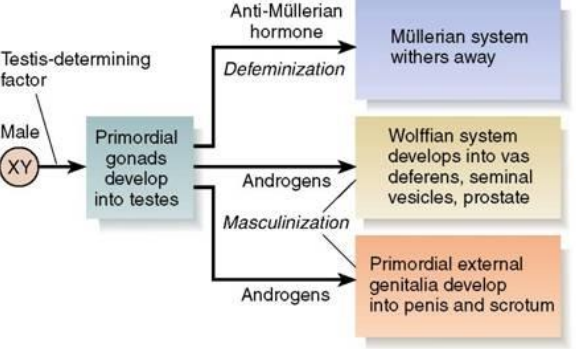
Defeminization
Triggered by anti-Müllerian hormone
Müllerian system withers away
Masculinization
Triggered by androgens
Wolffian system develops into vas deferens, seminal vesicles, prostate
Primordial external genitalia develop into penis and scrotum
Female reproductive organ development
XX chromosome
Primordial gonads develop into ovaries; no hormones are produced
Müllerian system develops into fimbriae, fallopian tubes, uterus, inner vagina
Wolffian system, without androgens, withers away
Primordial external genitalia develop into clitoris, labia, outer vagina
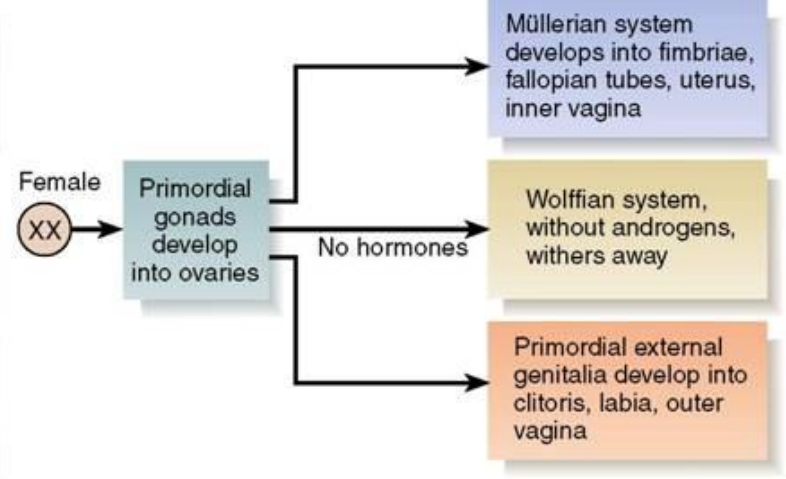
Activational effects
Puberty, a time period during which fertility is achieved, growth spurt occurs, and secondary sex characteristics develop; marked by surge in hormone release from the anterior pituitary
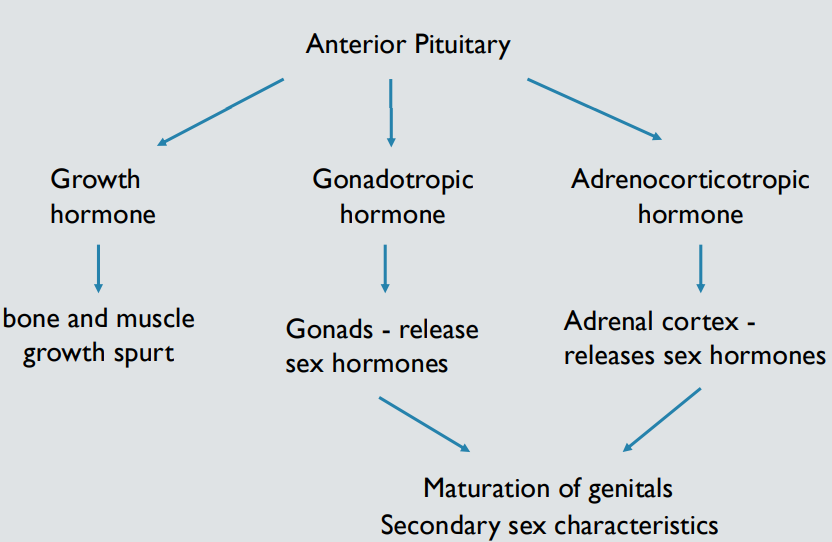
Pituitary
Anterior and posterior
Hypothalamus
Supraoptic and paraventricular
Posterior pituitary
Major hormones (Vasopressin and Oxytocin) signaled via neural connections and released into the blood; negative feedback signaling
Controls the secretion of anterior pituitary hormones via its own set of hormones; releasing and inhibitory factors

Vasopressin
Facilitates water reabsorption in the kidney
Oxytocin
Parental behavior
Releasing factors
Stimulate the release of an anterior pituitary hormone
Inhibitory Factors
Inhibit the release of an anterior pituitary hormone
Anterior pituitary
Considered to be the master gland because it releases tropic hormones
Part of the hypothalamic-pituitary portal system
Releases gonadotropins (see Neuroendocrine System: Gonads)
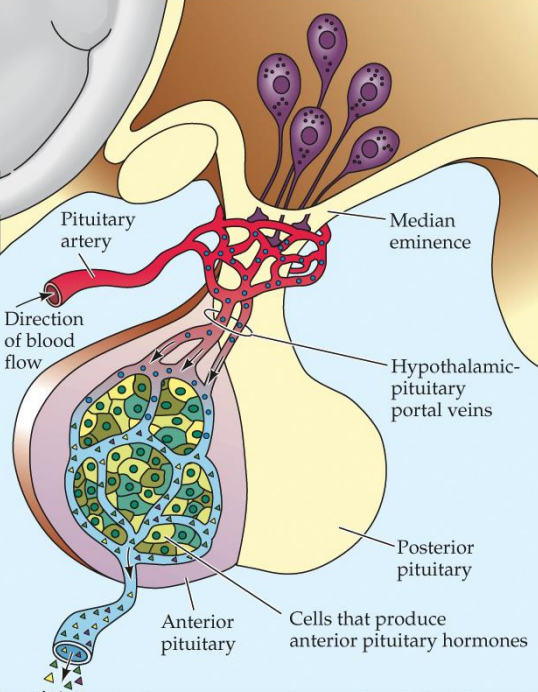
Hypothalamic-pituitary portal system
Carries GnRH from the hypothalamus to the anterior pituitary (see Neuroendocrine System: Gonads)
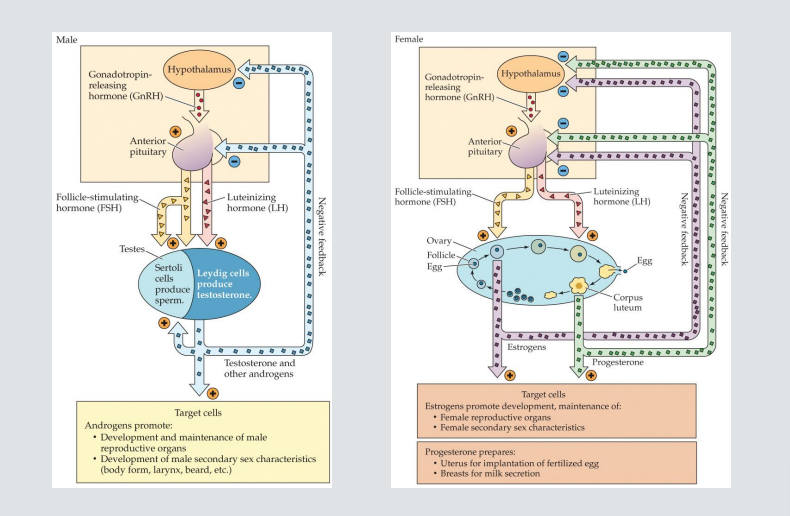
Tropic hormones
Primary function is to influence the release of other hormones
Prolactin, gonadotropic hormones (FSH and LH), thyroid-stimulating hormone, ACTH, growth hormone
Neuroendocrine cells
Special category of cell
Hormones
Chemicals released by endocrine glands into blood circulation
Act on target tissues throughout the body (including the brain) to produce physiological effects
Three main categories of hormones
Peptides, Amines, Steroids
Peptide hormones
Small protein molecules made of a string of amino acids
Bind to receptor proteins on the surface; activate second messengers; fast, but not as fast as synaptic signals
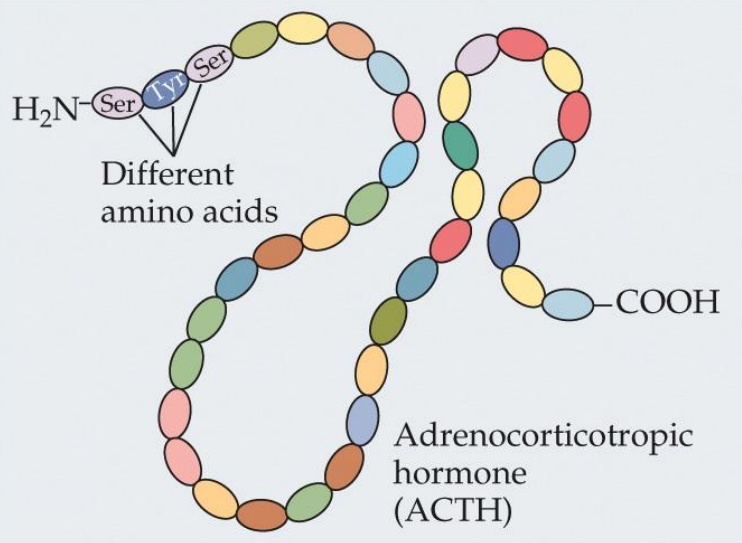
Amine hormones
Modified versions of single amino acids; smaller and simpler
Bind to receptor proteins on the surface; activate second messengers; fast, but not as fast as synaptic signals
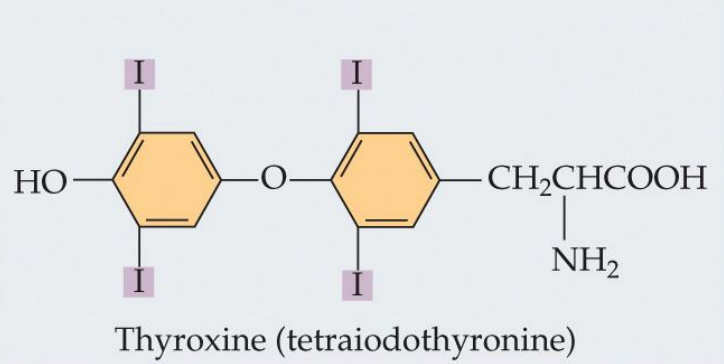
Steroid hormones
Derived from cholesterol; most important for sexual development and behavior
Bind to receptors inside the target cell; binds to DNA and controls expression of other genes

Hypothalamus
Control of hormone secretions
Pineal gland
Reproductive maturation; body rhythms
Anterior pituitary gland
Part of the pituitary gland
Hormone secretion by thyroid, adrenal cortex, and gonads; growth
Posterior pituitary gland
Part of the pituitary gland
Water balance; salt balance
Thyroid
Growth and development; metabolic rate
Adrenal cortex (outer bark)
Part of the adrenal glands
Salt and carbohydrate metabolism, inflammatory reactions
Adrenal medulla (inner core)
Part of the adrenal glands
Emotional arousal (epinephrine)
Pancreas
Sugar metabolism
Gut
Digestion and appetite control
Gonads (testes/ovaries)
Body development; maintenance of reproductive organs in adults
Homeostasis
Relatively stable internal environment optimized for cellular activity
Factors of homeostasis
Acidity, salt, water, oxygenation, temperature, energy availability
Example of homeostasis
Thermoregulation
Mammals are endotherms, meaning we make hear inside our bodies using metabolism and muscular activity; there is a dedicated, precisely regulated system for creating warmth
Set point
Desired homeostatic value (98.6°F or 37°C)
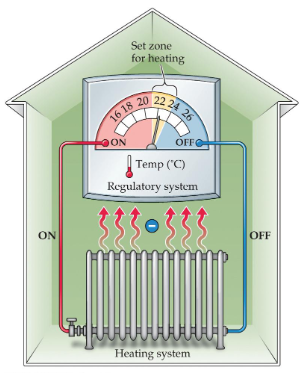
Negative feedback
Deviation leads to compensatory action of the system
Restoring the set point turns off the response
Redundancy
Each system has multiple mechanisms for monitoring stores, conserving remaining supplies, obtaining new resources, and shedding excesses
Example: pre-optic and lateral areas of the hypothalamus controlling temp
Behavioral Compensation
Behaviors that change the exposure of the body surface, external insulation, and/or surroundings
Allostasis
Dynamic process whereby the system shifts responses depending on prior experience and the environment
DSM-identified eating disorders
Anorexia Nervosa, Bulimia Nervosa, Binge-Eating Disorder
Anorexia Nervosa
Voluntary self-starvation despite more response to the presence of food than controls
Complex combination of genetic, endocrine, personality, cognitive, and environmental factors
Similar symptoms to Bulimia Nervosa, often difficult to distinguish
Bulimia Nervosa
Bingeing and purging
Similar symptoms to Anorexia Nervosa, often difficult to distinguish
Binge-Eating Disorder
Tendency to gorge oneself way past the point of fullness
Causes not well understood but thought to involve over activation of dopamine reward mechanisms
Obesity
Determined based on Body Mass Index (BMI)
Body Mass Index (BMI) calculation
kg/mxm OR 703(lb/inxin)
Starvation BMI category
Under BMI 15
Underweight BMI category
BMI 15 to 18.5
Normal BMI category
BMI 18.5 to 25
Overweight BMI category
BMI 25 to 30
Obese BMI category
BMI 30 or higher
Weight loss treatment
Is often extremely difficult; minimal success rates
Should ideally involve both diet and exercise
Requires permanent, substantial lifestyle changes; minimal evidence of long term success
Utility of drugs/supplements or surgery; strictly complementary to lifestyle changes
How can drugs promote weight loss?
Decreasing appetite, increasing metabolism, inhibition of fat tissue, blocking absorption of calories, reducing reward/cravings for specific foods, decreasing meal size (make you feel fuller faster)
To perform these functions, drugs may act in the CNS or the digestive tract
Health at Every Size (HAES)
Weight loss doesn’t have to be a goal; instead, the idea is to support people in adopting healthy habits for the sake of health and well-being (rather than weight control)
Recognizes that health and fitness can exist at all sizes
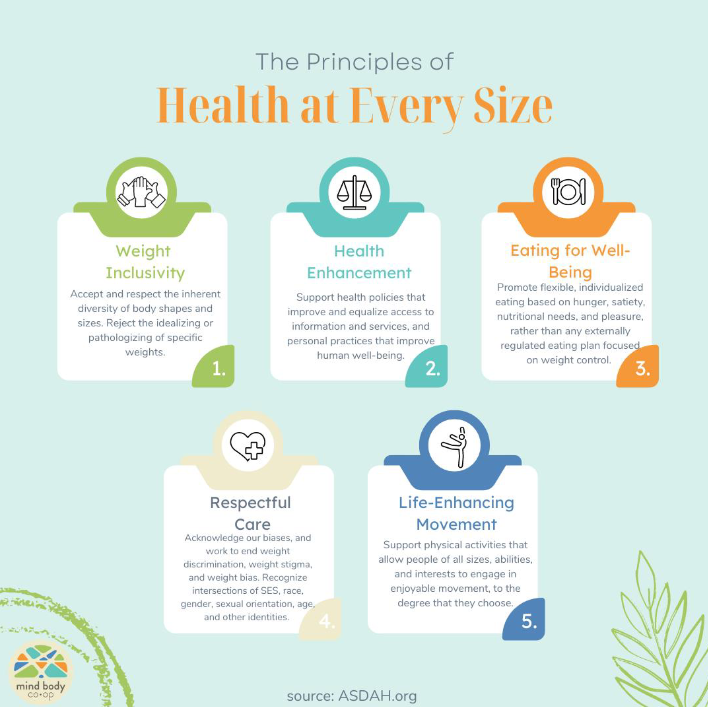
Hypothalamus
Complex effects on ingestive behavior
Regulation of energy balance; regulation of metabolism; motor behaviors
Depends critically on interconnections with other brain regions
Two regions of hypothalamus implicated
Ventromedial hypothalamus (VMH) and Lateral hypothalamus (LH)
Two types of peptide hormones
Satiety peptides and Hunger peptides
Satiety peptides
Decreases appetite
Cholecystokinin (CCK), α-MSH, Somatostatin, Leptin, PYY3-36, GLP-1
Hunger peptides
Increase appetite
Neuropeptide Y, Galanin, Orexin-A, Ghrelin
Basal metabolism
The majority of food energy is spent on things like heat, cellular activity, and maintenance of membrane potentials
Energy metabolism is under strict homeostatic control and can be adjusted
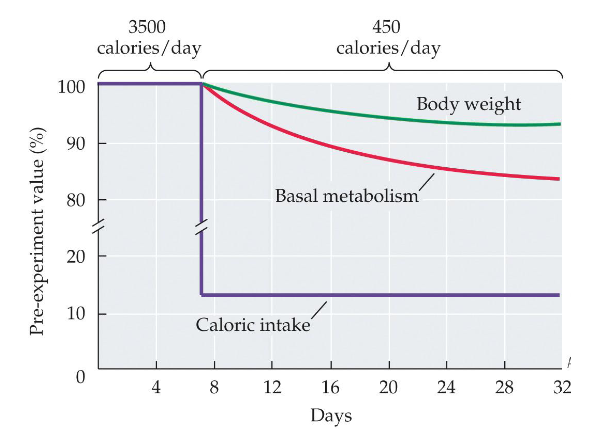
Short term storage
Insulin converts glucose to glycogen to store as reserve fuel
Glucagon converts glycogen back into glucose when stores are low
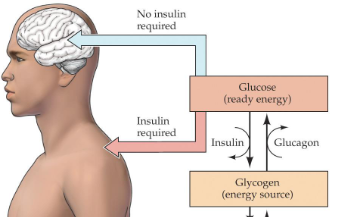
Long term storage
Insulin triggers lipid (far) storage in adipose tissues, liver, and muscles
Glucagon produces free fatty acids and ketones
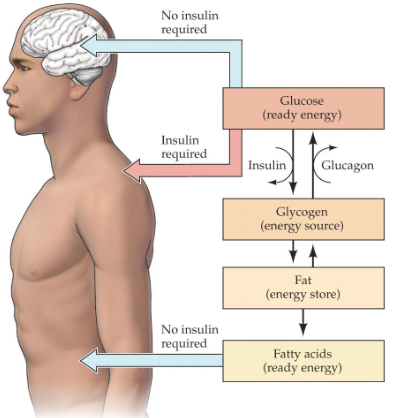
Three phases of energy metabolism
Cephalic phase, Absorptive phase, Fasting phase
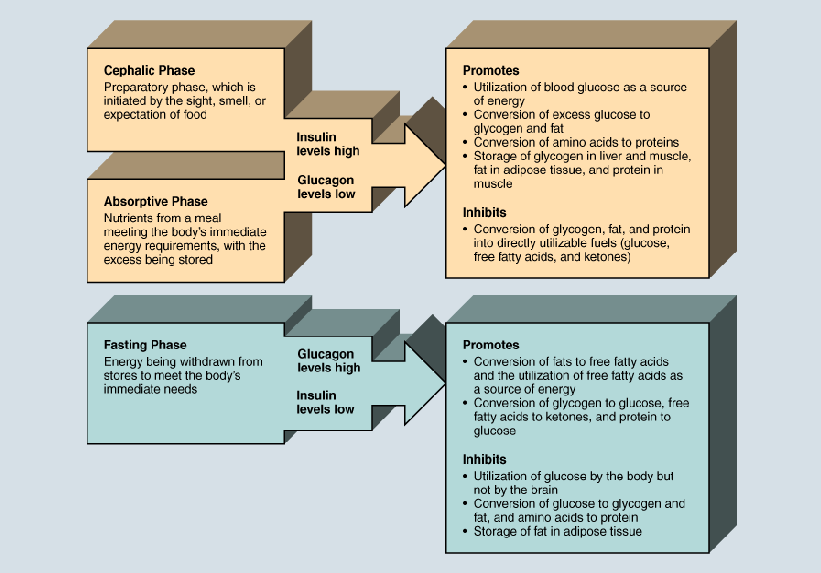
Cephalic phase
Preparatory phase, which is initiated by the sight, smell, or expectation of food
Insulin levels high; glucagon levels low
Absorptive phase
Nutrients from a meal meeting the body’s immediate energy requirements, with the excess being stored
Insulin levels high; glucagon levels low
Insulin levels high; glucagon levels low
Promotes utilization of blood glucose as a source of energy
Promotes conversion of excess glucose to glycogen and fat
Promotes conversion of amino acids to proteins
Promotes storage of glycogen in liver and muscle, fat in adipose tissue, and protein in muscle
Inhibits conversion of glycogen, fat, and protein into directly utilizable fuels (glucose, free fatty acids, and ketones)
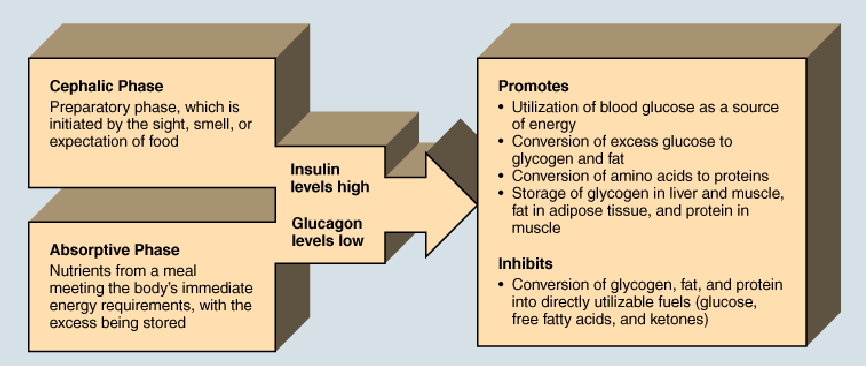
Fasting phase
Energy being withdrawn from stores to meet the body’s immediate needs
Glucagon levels high; insulin levels low
Glucagon levels high; insulin levels low
Promotes conversion of fats to free fatty acids and the utilization of free fatty acids as a source of energy
Promotes conversion of glycogen to glucose, free fatty acids to ketones, and protein to glucose
Inhibits utilization of glucose by the body but not by the brain
Inhibits conversion of glucose to glycogen and fat, and amino acids to protein
Inhibits storage of fat in adipose tissue
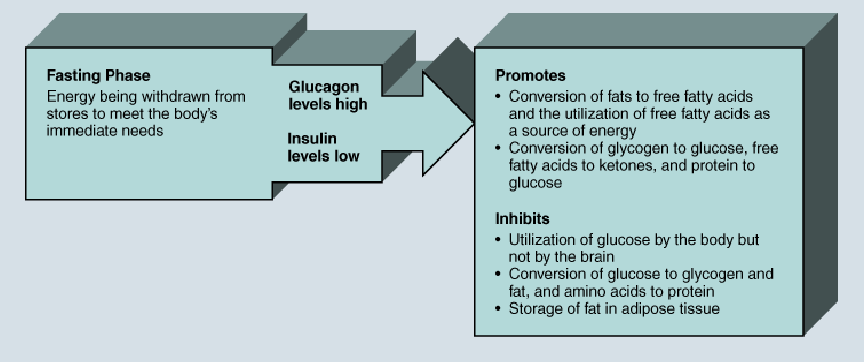
Insulin
Required by glucose transporters in the body to allow use of glucose in the body
Diabetes Mellitus
Lack of insulin production or reduced sensitivity to insulin
Theories of hunger
Set point theory and Positive-incentive theory
Set point theory assumption
Hunger is a response to an energy need; we eat to maintain an energy set point
Set point theory problems
Not everyone is the same size
It doesn’t fit evolutionary pressures; energy storage necessary for survival
Reductions in blood glucose or body fat do not reliably induce eating
It doesn’t account for the influence of external factors on eating and hunger (taste, learning, social cues)
Positive incentive theory
We are drawn to eat by the anticipated pleasure of eating
We have evolved to “crave” food
Eating has a positive-incentive value; multiple factors interact to determine this
Accounts for the impact of external factors on eating behavior
Water Balance
A precise balance of fluids and dissolved salts surround all of the cells of the body to allow proper functioning; approximately like diluted seawater
Important to maintain a decent ratio of water in the intracellular compartment vs the extracellular compartments; happens via diffusion and osmosis
Diffusion
Passive spread of the salt components (ions) to evenly space them in the water

Osmosis
Movement of water molecules to equalize the concentration of two solutions on either side of a semi-permeable membrane
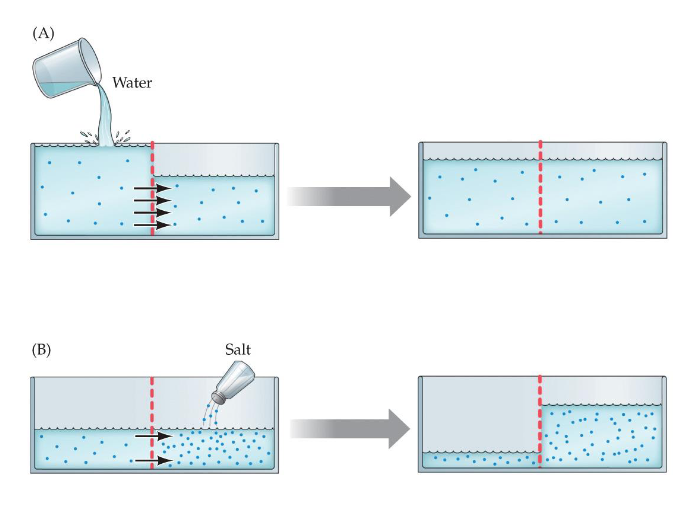
Two types of water imbalance (thirst)
Osmotic thirst and Hypovolemic thirst
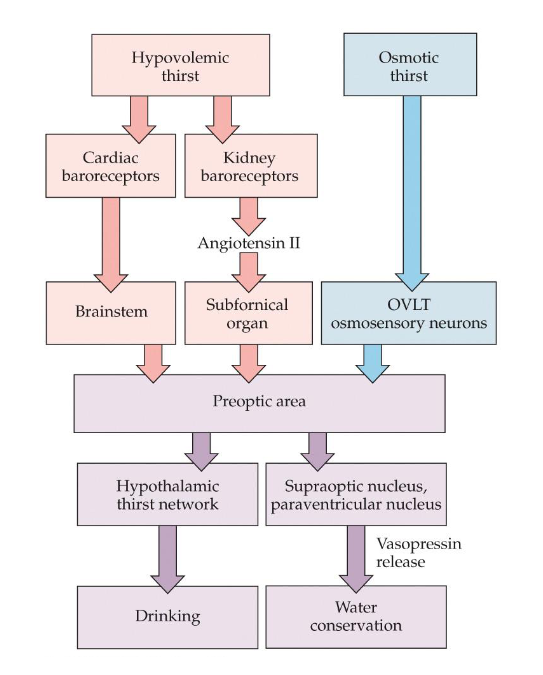
Osmotic thirst
Volume of extracellular fluid is slightly decreased due to obligatory losses
Concentration of salt in the extracellular fluid increases
Results in water being drawn out of the cells
Detected by osmosensory neurons
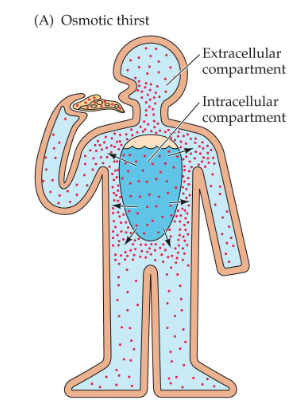
Hypovolemic thirst
Caused by a more significant decrease in the overall volume of extracellular fluid
Due to vomiting, hemorrhage, or sustained diarrhea; detected by baroreceptors
Doesn’t change concentration, just volume
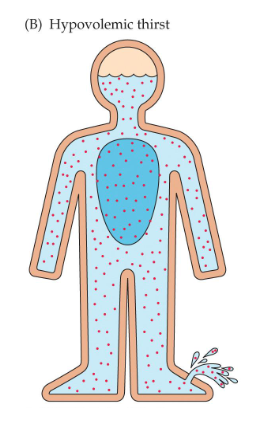
How the brain controls sleep
Forebrain system that generates SWS
Brainstem system that activates the sleeping forebrain to wakefulness (reticular activating system of the brainstem)
Pontine system that triggers REM sleep (REM sleep nuclei in the pons)
Hypothalamic system that coordinates the others
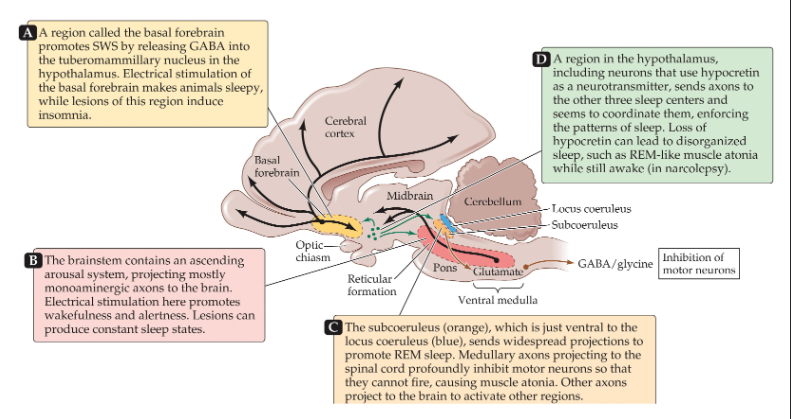
Sleep disorders
Insomnia, hypersomnia, sleep apnea, unreliable respiration, nocturnal myoclonus, narcolepsy, nightmares, night terror, REM behavior disorder, sleep paralysis
Sleep apnea
Unreliable respiration
Nocturnal myoclonus
Restless leg syndrome
Nightmares vs night terror
Nightmares are frightening dreams; night terror is arousal from SWS, intense fear
Narcolepsy
Daytime sleep attacks, cataplexy, sleep hallucinations
REM behavior disorder
Act out a dream while sleeping
Sleep paralysis
Inability to talk/move upon waking or falling asleep
Drugs that affect sleep
Hypnotic drugs and anti-hypnotic drugs
Hypnotic drugs
Benzodiazepines, Ambien, Melatonin
Anti-hypnotic drugs
Stimulants and tricyclic antidepressants